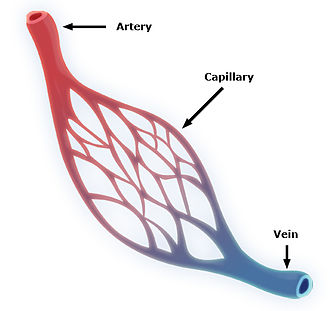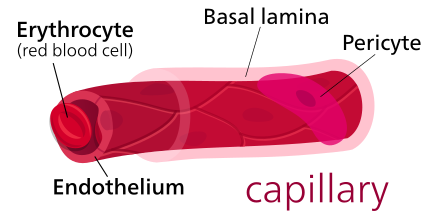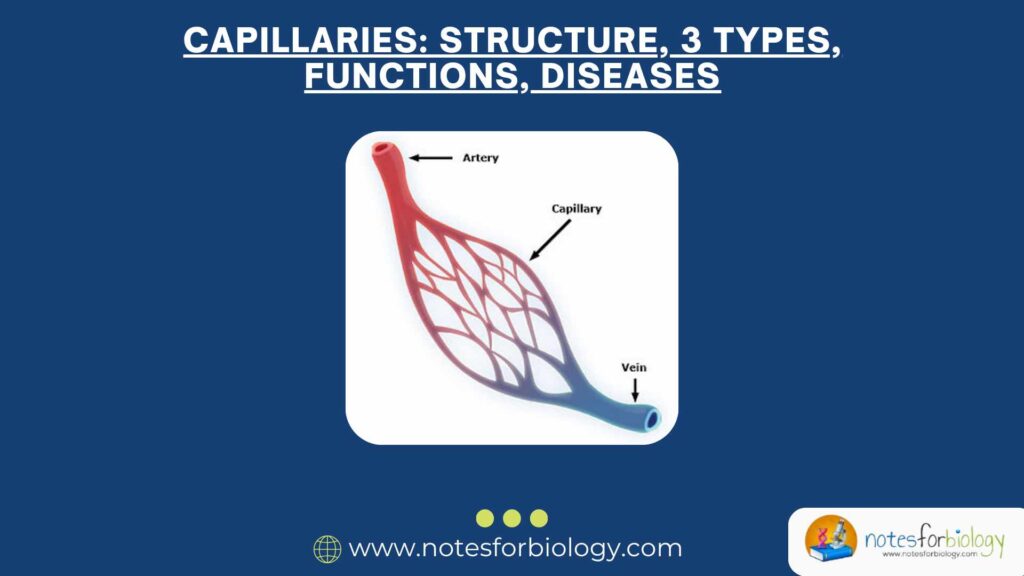What Are Capillaries?

Capillaries are the smallest blood vessels in your body, forming a vast network that connects arteries (which carry blood away from the heart) to veins (which return blood to the heart). They are so tiny that red blood cells often pass through them in single file. Their thin walls allow for the exchange of oxygen, nutrients, and waste products between the blood and surrounding tissues.
Summary of Capillaries
- Capillaries are the body’s tiniest blood vessels, forming a vast network that connects arteries to veins.
- Their ultra-thin walls allow for the efficient exchange of oxygen, nutrients, and waste between blood and tissues.
- This microcirculation system is essential for sustaining life, supporting every cell’s function throughout the body.
Table of Contents
Structure of Capillary

Capillary are composed of a single layer of endothelial cells, which are flat, thin cells forming the inner lining of the blood vessel. This simple structure facilitates the easy exchange of substances between the blood and tissues. Some capillaries also have tiny pores or gaps that enhance this exchange process.
Types of Capillaries
There are three main types of capillaries, each adapted to specific functions in different parts of the body:

1. Continuous Capillary
- Structure: These have uninterrupted endothelial cells with tight junctions.
- Location: Found in muscles, lungs, and the central nervous system.
- Function: Permit the exchange of water and small molecules; restrict larger molecules.
2. Fenestrated Capillary
- Structure: Contain pores (fenestrations) in the endothelial lining.
- Location: Present in kidneys, intestines, and endocrine glands.
- Function: Allow for rapid exchange of substances like hormones and nutrients.
3. Sinusoidal (Discontinuous) Capillary
- Structure: Have large gaps between endothelial cells and a discontinuous basement membrane.
- Location: Located in the liver, spleen, and bone marrow.
- Function: Enable the passage of large molecules and cells between blood and tissues.
Functions of Capillary
Capillary play a crucial role in the circulatory system:
- Exchange of Gases: Deliver oxygen to tissues and remove carbon dioxide.
- Nutrient Delivery: Transport nutrients like glucose and amino acids to cells.
- Waste Removal: Carry waste products away from tissues for excretion.
- Hormone Transport: Distribute hormones throughout the body.
- Temperature Regulation: Adjust blood flow to help regulate body temperature.
Diseases and Disorders Related to Capillary
Several health conditions are associated with capillary dysfunction:
1. Capillary Leak Syndrome
A rare condition where fluid and proteins leak out of capillary into surrounding tissues, leading to swelling and low blood pressure.
2. Diabetic Microangiopathy
High blood sugar levels damage capillary, especially in the eyes (diabetic retinopathy), kidneys (diabetic nephropathy), and nerves (diabetic neuropathy).
3. Hypertension (High Blood Pressure)
Chronic high blood pressure can damage capillary walls, leading to reduced elasticity and function.
4. Inflammation
Inflammatory responses can increase capillary permeability, causing redness, heat, and swelling in affected areas.
5. Tumor Angiogenesis
Tumors can stimulate the formation of new capillaries to supply nutrients, aiding in their growth and spread.
Importance of Capillary in Overall Health
Maintaining healthy capillary is vital for overall well-being:
- Efficient Circulation: Ensures tissues receive adequate oxygen and nutrients.
- Waste Removal: Prevents accumulation of harmful waste products.
- Immune Function: Facilitates the movement of immune cells to sites of infection or injury.
- Healing: Supports tissue repair and regeneration.
Conclusion
Capillaries, though microscopic, are essential components of the circulatory system. Their unique structures and functions enable the vital exchange of substances between blood and tissues, supporting every cell in the body. Understanding their role and maintaining capillary health through proper diet, exercise, and medical care is crucial for overall health and the prevention of various diseases.
Frequently Asked Questions (FAQs)
What happens if capillaries are damaged?
Damage to capillary can impair the exchange of gases and nutrients, leading to tissue dysfunction. Conditions like diabetes and hypertension can damage capillaries, resulting in complications such as neuropathy or organ damage.
Can capillaries regenerate?
Yes, capillary can regenerate through a process called angiogenesis, especially in response to tissue injury or increased demand for blood flow. This ability is crucial for healing and adapting to changes in the body’s needs.
How can I keep my capillaries healthy?
Maintaining healthy capillary involves:
Regular exercise: Improves circulation and promotes capillary health.
Balanced diet: Provides nutrients essential for vascular health.
Managing blood pressure and blood sugar: Prevents damage to capillary walls.
Avoiding smoking: Smoking can damage blood vessels, including capillaries.
Related Articles




